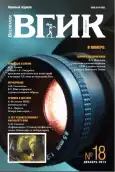Том 5, № 4 (2013)
- Год: 2013
- Статей: 15
- URL: https://journals.eco-vector.com/2074-0832/issue/view/889
- DOI: https://doi.org/10.17816/VGIK54
Статьи
В этом месте, у самой реки...
Вестник ВГИК. 2013;5(4):145-147
 145-147
145-147


Теперь нам сорок...
Вестник ВГИК. 2013;5(4):148-150
 148-150
148-150


ТЕОРИЯ И ИСТОРИЯ КИНО | ЭКРАННЫЕ ИСКУССТВА
Альтернативные формы кинопроката и кинофикации в СССР в 1920-е годы
Аннотация
В статье рассматривается процесс восстановления отечественной киноиндустрии после революции, в частности, кинофикации страны. Освещаются вопросы кинорепертуарной политики, проблема формирования репертуара при почти полном отсутствии собственного кинопроизводства. Анализируются также альтернативные формы кинофикации и кинопроката (агитпоезда, агитпароходы и пр.), рассматриваются принципы продвижения зарождающегося советского кинематографа по всей стране.
Вестник ВГИК. 2013;5(4):6-20
 6-20
6-20


Советские киноэкспедиции 1930-х годов глазами жителей большого Токио
Аннотация
Начало 1930-х годов — переломный этап в истории Японии и ее кинематографа. Переход к звуку, быстрое развитие документального жанра и использование его в пропагандистских целях происходили на фоне интереса профессионалов к опыту советского кино, к его монтажной выразительности, документальности стиля и идеологической ангажированности. В эти годы был создан звуковой документальный фильм В. Шнейдерова «Большой Токио» (1932). По различным причинам долгое время фильм оставался забытым. Основываясь на японских и советских источниках, постараемся вернуть киноленту «Большой Токио» в исторический контекст начала 1930-х, проанализировать восприятие советского документального кино в довоенной Японии.
Вестник ВГИК. 2013;5(4):21-28
 21-28
21-28


КИНОЯЗЫК И ВРЕМЯ | ГЕНЕЗИС ОБРАЗА
«Фауст» А. Сокурова: проекция политических катастроф в истории XX века на трагедию Гёте как проблема
Аннотация
Фильм А. Сокурова, поставленный по трагедии Гёте «Фауст», не является экранизацией в привычном смысле этого слова. Использование классического произведения для высказывания о современности способно обернуться вульгарным и поверхностным толкованием. Но, как свидетельствует фильм, идея режиссера включить новый фильм в тетралогию, т. е. в группу его фильмов, посвященных диктаторам ХХ века, диктует внимательное чтение первоисточника. Пытаясь разобраться в первичных интенциях замысла Гёте, автор статьи (цикл статей, начало в № 17) обнаруживает исходную точку возникновения в западной культуре комплекса демонизма, объясняющего, в том числе, и восприятие в политической истории ХХ века вождей.
Вестник ВГИК. 2013;5(4):30-41
 30-41
30-41


Музыкальный минимализм в кинематографе: метаморфозы времени и самоявление звука
Аннотация
В статье (окончание, начало в № 17) рассматривается роль музыкального минимализма в эстетическом восприятии и теоретической интерпретации кинопроизведения. Анализ принципов музыкального минимализма в кинематографе конкретизируется в двух основных явлениях: трансцендировании художественного пространства через самоценность отдельного звука и изменении смысла времени через репетитивность музыкальной техники.
Вестник ВГИК. 2013;5(4):42-51
 42-51
42-51


О подходах к построению теории художественного времени: М.М. Бахтин, Ж. Делёз
Аннотация
В статье исследован опыт заимствования искусствоведением концепта «хронотоп» из релятивистской механики, показаны границы метода хронотопического анализа при исследовании произведений литературы и кинематографа, выявлены возможности устранения возникших затруднений теории хронотопа в работах А. Бергсона и Ж. Делёза.
Вестник ВГИК. 2013;5(4):52-64
 52-64
52-64


Образ гофмановского двоемирия в фильме «Гофманиада»
Аннотация
В фокусе статьи находится художественное пространство первых двух частей фильма С. Соколова «Гофманиада». Анимационное художественное пространство анализируется в сравнении с пространством сказок Э.Т.А. Гофмана. Акцент делается на исследовании выразительных средств, позволяющих конструировать дуалистическое гофмановское пространство в анимации.
Вестник ВГИК. 2013;5(4):78-89
 78-89
78-89


ПЕРФОРМАНС | ИСКУССТВО ВОПЛОЩЕНИЯ
К.Г. Юнг о природе художественного образа
Аннотация
В статье анализируются подходы К. Юнга к проблеме символа и архетипа, рассматриваются отношения между композиционной целостностью художественного произведения и архетипическим образом как явлениями, прочно коренящимися в глубинах неосознаваемых психических процессов.
Вестник ВГИК. 2013;5(4):66-77
 66-77
66-77


КУЛЬТУРА ЭКРАНА | КУЛЬТУРОЛОГИЯ. ФИЛОСОФИЯ
 92-101
92-101


Образы Китая на российском экране. Взгляд из зрительного зала
Аннотация
Прошедший в России в сентябре 2013 года Фестиваль китайского кино послужил для авторов статьи поводом для социологического анализа некоторых тенденций в современном китайском кинематографе, связанных с формированием имиджа Китая как великой державы. В статье рассматриваются вопросы взаимодействия культур в экранной форме.
Вестник ВГИК. 2013;5(4):102-111
 102-111
102-111


МИРОВОЙ КИНОПРОЦЕСС | АНАЛИЗ
Видимый и невидимый мир в фильме Л. Бунюэля «Виридиана»
Аннотация
Распространено мнение, что фильм «Виридиана» Л. Бунюэля относится к разряду антирелигиозных картин. Однако поэтический язык режиссера, являющийся основой трансцендентального стиля в кино, свидетельствует об обратном. Бунюэль восстает против ложной веры, но он вовсе не отрицает существование сверхчувственной, метафизической реальности, высших ценностей бытия и, прибегая к методу гротескного реализма, пытается восстановить невидимый мир в его правах.
Вестник ВГИК. 2013;5(4):114-120
 114-120
114-120


КИНОБИЗНЕС | СТРАТЕГИЯ И ТАКТИКА УПРАВЛЕНИЯ
Критерии эффективности подразделения компьютерной графики
Аннотация
Компьютерная графика в современном кино формирует уникальное явление сродни системе актеров-звезд, становясь «приманкой» для массового зрителя. В статье обозначены проблемные аспекты управления персоналом в условиях перехода фильмопроизводства на цифровые технологии, в частности, при создании компьютерных спецэффектов.
Вестник ВГИК. 2013;5(4):126-136
 126-136
126-136


ТЕЛЕВИДЕНИЕ | ЦИФРОВАЯ СРЕДА
О противостоянии медиумов и новых формах экранного продукта
Аннотация
Переход ТВ на цифровую платформу вещания, обновляющееся медиапространство влекут перемены в программной политике телеканалов. Изменение условий существования ТВ как субъекта рынка обусловливает реформирование его организационно-творческо-производственной деятельности. Поиск новых форм и концепций экранного контента сопряжен также с трансформациями в социальной среде. В статье рассматривается проблема противостояния медиумов — медиа и социума, особо проявившаяся в цифровой период, влияние инновационных технологий на появление новых форм экранного продукта.
Вестник ВГИК. 2013;5(4):138-144
 138-144
138-144


ЗАРУБЕЖНОЕ КИНО В ЛИЦАХ | ТВОРЧЕСКИЙ ПОРТРЕТ
 121-124
121-124












